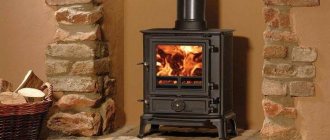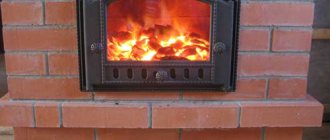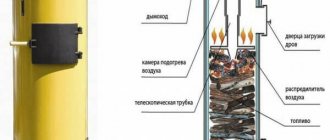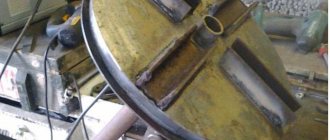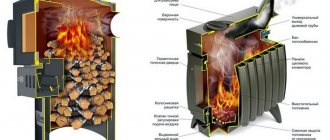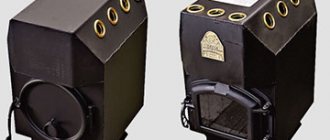- home
- Vacation home
- Engineering
Natalie
1
(1)
Reading time: 15 minutes
Every house needs heating during long frosty winters. It would be impossible to live in a house without heat. Anyone who wants to fill their home with life-giving warmth thinks about how they organize heating.
The editors of Agronom.guru invite you to familiarize yourself with wood-burning stoves, the efficiency of which is 90%. These are the best long-burning wood stoves for your home. We have looked at all the pros and cons of such heating systems and offer to find out what types of long-burning wood stoves are available and how to operate them correctly.
Also, if you are planning to choose stoves for a wood-burning sauna, be sure to know:
- Steam room volume;
- Fuel;
- Oven type;
- Microclimate;
- Door;
- Advantages and disadvantages of long-burning wood-burning stoves
- Design of long-burning furnaces
- Operating principle of long-burning furnaces
- Main technical characteristics of long-burning wood-burning stoves
- How to choose a long-burning wood stove
- How to increase the efficiency of a long-burning wood stove
- Types of long-burning wood-burning stoves for heating a house and other buildings Long-burning wood-burning stoves-fireplaces for a home or cottage
- Boilers
- Ovens with hobs
Advantages and disadvantages of long-burning wood-burning stoves
Any unit has disadvantages and advantages; studying such nuances allows you to choose the optimal model for heating your dacha.
| Advantages | Flaws |
| Economical fuel consumption. | There are often difficulties with the design of the chimney. |
| High efficiency. | To implement the pyrolysis mode of the furnace, pre-heating of the house is required. Until this moment, the unit operates as usual. |
| Large selection of sizes to suit every taste. | |
| Fueling occurs infrequently: from 5 to 48 hours. | |
| Possibility of using liquid and solid fuel. |
Design of long-burning furnaces
Long-burning wood-burning stoves have their own design features. To reduce intense combustion, the air supply is controlled in several ways: upper or lower combustion and pyrolysis of wood. The most common option is top combustion. With this method, firewood smolders from top to bottom to the base of the firebox. The combustion area is limited by the supply of dosed air. Below is a picture explaining the design of a wood stove for long-term burning.
You can see the role played by the supply of cold air, a hot air chamber with a cut-off valve that meteres the supply of oxygen into the combustion chamber. Often such stoves are equipped with a convenient ash pan-scoop.
Operating principle of long-burning furnaces
Let's get acquainted with the operating principle of a long-burning wood-burning heating stove for a country house. The process that occurs in the combustion chamber is called pyrolysis or gas generation. This can be described with the word “smoldering”, since the concentration of supplied oxygen is extremely low, combustion as such does not occur.
So, solid fuel is placed in the stove and set on fire. The role of the blower during ignition is important; the damper must be fully open. First, the wood is heated and completely dried. The process of heat transfer and release of flammable gases begins. These gases pass into the upper chamber and burn there. The house should warm up within 30-40 minutes. After this, close the blower damper in order to block the access of oxygen.
At this point, you can add new fuel. The combustion mode at the lower level makes the most useful use of pyrolysis gas. The chemical processes taking place in the bowels of the stove in wood fuel are such that the raw material does not burn, and in the absence of air access it releases pyrolysis gas, ash and other elements. All this combustible mass accumulates at the top of the combustion chamber and transfers heat to the walls of the furnace, to the heat exchanger or convector.
Main technical characteristics of long-burning wood-burning stoves
Like any other device, long-burning stoves have their own technical characteristics:
- power;
- the material from which the firebox is made;
- unit weight;
- external finishing material.
The time it takes for the house to be completely heated depends on the technical characteristics, on average it is from 3 to 10 hours. The area of the heated room varies from 75 to 250 m² and depends on the design of the stove. Stoves are made of steel, cast iron or brick. Wood-burning metal stoves for homes are also in demand. For dachas, there are such convenient types of long-burning stoves as heating and cooking models, on which you can cook and warm up food, as well as fireplace stoves.
Long-burning heating and cooking stove
Basic masonry techniques
In production, heat-resistant and fire-resistant materials for the firebox, as well as hardened bricks, are used. It is not recommended to build a stove yourself. It is necessary to contact specialists for high-quality and safe masonry.
Specialists carry out work in compliance with all safety standards and regulations. For laying bricks, cement mortar is used, which is diluted with sand in a ratio of 1 to 3.
For binding material, many craftsmen use clay and sand.
Each row of bricks is laid out in a certain way to form a stove for a given project. Source pechki.net.ru
How to choose a long-burning wood stove
If you want to purchase equipment only for heating rooms, then you need to decide what function such a unit will perform - to serve as the only source of heat or as an addition to a gas or electric boiler. Another important question: are you interested in cooking with such equipment? If you need a long-burning stove for a garage or home, then take into account such important parameters as power and dimensions. If the room is not very large and you need to warm it up quickly, then you should pay attention to steel models. Here are several options for long-burning stoves.
How to increase the efficiency of a long-burning wood stove
To improve heat transfer and save firewood consumption, they are thinking about increasing efficiency. This can be achieved using forced air supply by a fan installed next to the stove. It promotes air circulation.
Another way would be to install a water heat exchanger on the chimney pipe. Such a device will take heat from the exhaust gas and transfer it through water to the room. Increasing efficiency is impossible when using unseasoned firewood. But in general, reviews of such stoves indicate a very high efficiency, so increasing it is unlikely to be necessary.
Precautionary measures
An ordinary furnace cannot be converted into a gas generator. Such manipulations will only lead to smoke in the building. In order to fully use a gas generator device, it is necessary to take into account its disadvantages.
Cold gas is formed at the outlet of such equipment. If the chimney is not properly insulated, condensation occurs. The moisture will flow back into the device. Therefore, experts recommend the use of insulated sandwich structures. They consist of 2 pipes nested inside each other, between which the insulation is located.
In order for the gas generator to operate as efficiently as possible, it is necessary to install an economizer (additional equipment).
Types of long-burning wood stoves for heating houses and other buildings
Numerous manufacturers offer various options for long-burning stoves that you can buy for your home. If you do not want to use the unit for cooking, then you should think about purchasing a Finnish stove for heating your home. As an option, you can make a brick oven for your home with your own hands.
Long-burning wood burning stoves for your home or cottage
Economical in fuel consumption and decorating the interior, wood-burning stoves-fireplaces for the home last a very long time. Ignition and heating of the room take place in a short time. Some models are equipped with hobs.
It is convenient to remove ash while the fireplace is operating. But despite their interesting appearance, such devices distribute heat worse. At the top of the room it is much warmer than closer to the floor. Another disadvantage is the active formation of soot on the internal surfaces of pipes due to the condensation of very hot smoke. With such actively used fireplaces, the chimney needs to be cleaned quarterly.
Boilers
A boiler is another commonly chosen unit for heating a home, which also works by smoldering wood while restricting air access. The main advantage of boilers is that there is no need to frequently add fuel. The technical characteristics of such heating equipment depend on the model version. The next stacking of firewood can be done in a few hours. The maximum period is 12 hours. It is not necessary to burn with wood; solid fuel will also work.
Other communications do not need to be connected to the boiler. Such devices are not cheap, and the efficiency rarely exceeds 89%. Another disadvantage is the inability to adjust the temperature.
Ovens with hobs
This additional function of a long-burning stove, such as cooking, is pleasantly combined with the overall reliability of the unit. Such equipment will fit perfectly into the kitchen environment, as modern design is very diverse. Numerous models presented by manufacturers are easy to transport and install without problems. It is recommended to use only high quality firewood. Otherwise, efficiency decreases. There are some difficulties with lowering the temperature on the metal surface of some units. When choosing a model, it is better to opt for those that have an additional shutter to lower the temperature.
We save wisely: an energy-saving electric heating boiler. In a special publication on our portal, we will talk in detail about electric heating energy-saving boilers. You will learn the operating principle of energy-saving electric heating boilers, types of boilers, installation features and comparative characteristics of boilers.
Advantages of this type of heating
Let's consider the efficiency of savings and stability of the air system:
- Reduce costs by 10-20%. An air-heated fireplace continues to function for some time after extinguishing due to circulating hot air in the pipes. Even after extinguishing, the heating system continues to heat a private home;
- Using hot smoke. The temperature of the smoke escaping into the atmosphere is 170-200 degrees. So why not use this gas as an additional heat source to warm the room? Such fireplaces are equipped with a special air duct for circulating hot smoke;
Air heating operation diagram
Ventilation and heating
The considered advantages of air heating speak eloquently about the effectiveness of such a heating system. Ducted heating systems boast three heating methods:
- Convection. By mixing cold and hot air;
- Heat transfer. The walls of the house are well heated by hot air;
- By radiation. The heat comes from the open fireplace insert.
Such a complex heating system can only be installed during the construction of a new house. It is quite difficult to install such a system with your own hands. Its installation requires an excellent understanding of drawings, significant costs for pipe materials, adapters and sealing agents. In addition, it is better to entrust the installation of the ventilation system to a specialist, whose work, of course, is paid.
Furnace models and manufacturers
You can buy an inexpensive stove from a well-established manufacturer and use it with pleasure for many years, or you can buy expensive equipment, the reviews of which are very unflattering. We invite you to get acquainted with the highest quality manufacturers and best models of stoves.
"Buleryan"
Stoves with such an interesting name began their journey into homes from Canada. A characteristic feature is the steel firebox in the form of a cylinder. The thickness of the steel is 6 mm. The firebox door is located at the end, which is very convenient. Pipes with a round or rectangular cross-section are welded to the body of the unit. When the firebox warms up and transfers heat to the air inside, the convection process begins.
The design is equipped with a grate in a cylindrical chamber and a partition inside, which divides the firebox itself into two halves. Fuel is placed in the first half, and pyrolysis gas is burned in the second. The location of the chimney is opposite to the chamber door. The chimney itself begins inside the combustion chamber, so all elements of the combustion process circulate along the front wall and, rising up, exit into the chimney opening.
"Buleryan" - very practical stoves with high efficiency
Butakov furnaces
These long-burning wood stoves are suitable not only for heating houses in the harsh winter, but also for baths. There are several models of this brand that have excellent characteristics. The “Student” model, with a power of 9 kW and a weight of 70 kg, offers good heating of a room of 150 cubic meters of space, and the “Professor” model, with a power of 40 kW and a weight of 235 kg, heats a space of 1000 cubic meters. Other models are called “Engineer”, “Academician” and “Associate Professor”. Their powers are, respectively, 15, 25 and 55 kW, and their weight is 113, 164 and 300 kg. The heated volume of the “Engineer” model is 250 cubic meters, the “Associate Professor” has about 500 cubic meters, and the “Academician” copes well with a volume of 1200 cubic meters.
Butakov stoves are designed for the coldest winters.
"Breneran"
In Russia, an analogue of the models from Canada that has excellent technical characteristics has been created. Manufacturing is carried out according to European quality standards. Let's look at the Breneran stove models. They go under the names AOT and digital ordinal index. The lower the power, which for the AOT-6 model is 6 kW, and for the AOT-19 model is 35 kW, the less spatial volume the stove can heat. AOT-6 copes with heating 56 m2, and AOT-19 completely heats 260 m2. The number index of Breneran stoves is located in such a way that the lower the serial number, the smaller the weight and heated area.
Sometimes glass doors are included in the package, and you can connect the unit to the water circuit. The disadvantages include condensation entering the room where the stove is located. This occurs due to a lack of tightness on the smoke fitting.
"Breneran"
"Teplodar"
Russians have taken a responsible approach to the problem of heating premises in our frosty winters and offer stoves of good quality and high efficiency. Teplodar brand ovens are compact and light in weight. The Matrix-200 model provides heat to a room of 200 m2. The external design of the stove looks aesthetically pleasing and will perfectly complement the interior of the room. The compact Siberia model covers a smaller space, but warms up the room very quickly. There is an excellent option for heating kitchens. For this purpose, the manufacturer offers a “Vertical” fireplace stove with a hob.
"Vesuvius"
Russian long-burning stove for any premises: country house, bathhouse, garage. Its small size allows it to be used in any outbuilding. You can choose a model based on the requirements of the room. The design of these stoves is such that pipes welded inside the firebox help the passage of hot air, which plays a role in uniform heating of the space.
“Vesuvius PK-01” will attract attention in any room and will serve well for many years
"Termofor"
What can you say about the domestic development of Termofor stoves? These are several models with interesting names and very compact sizes and a power of 413 kW. The heated space depends on the model and varies from 50 to 250 m3.
"Termofor" - fire-battery
"Ermak"
Reliable heating devices with low weight and compact dimensions. Ermak brand stoves have proven themselves well and are installed both in country houses and in residential buildings.
There are models with a hob
Installing a long-burning stove with your own hands
If you have not opted for any of the designs presented above, then we suggest approaching the issue of heating your home from a different angle. You can make your own wood-burning brick oven for your own home. The Internet is replete with drawings of brick stoves with instructions; with the help of such home-made units you can successfully heat a house for many years. The drawing below will help you make such a stove yourself.
To install a long-burning stove with your own hands, you will need to take care of a set of pipes for the chimney. Their diameter must match the diameter of the furnace pipe. The method of installing the chimney is vertical or external.
Chimney assembly diagram
After installing the chimney, the stove is assembled and installed in the chosen location. If necessary, use a special sealant for the fireplace. The most important point will be the tight connection between the stove and chimney structure.
What can you say about brick?
Brick is a good and reliable material for making a stove. But it has a significant disadvantage - it takes a long time to warm up the house in order to achieve a comfortable temperature, since brick has inertial properties.
Therefore, in order to warm up the house well, you will need to consume a large amount of fuel.
From all this, only steel remains. In the next chapter, we will tell you how to make a long-term storage oven with your own hands using a metal barrel.
Long-burning wood stoves: prices, where to buy inexpensively
The price range of such heating equipment has a wide range.
Selecting and ordering through online suppliers will be the easiest solution. For this purpose, many convenient catalogs have been created, where all the technical characteristics of the unit are indicated; in the photo you can see the nuances of the appearance and find out about the availability of the stove in the store and delivery methods. If there are representatives of the brands you are interested in in your city, the purchase will be cheaper. The price of cast iron stoves “Surpa” is on average 120,000-140,000 rubles. Domestic stoves are much cheaper. “Teplodar” and “Termofor” are available at a price of 20,000-30,000 rubles. Vesuvius stoves can be purchased for 10,000 rubles.
The prices of stoves for home water heating depend not only on the manufacturer, but also on the supplier. Breneran stoves, model AOT-14, can be purchased for 28,000 rubles. Delivery costs to remote locations will be higher.
If you have any other questions that we touched upon in passing or that were not covered in the article, then please voice them in the comments.
Mistakes when choosing an air-heated fireplace
The generally accepted scheme for selecting heating equipment is unacceptable in this case. Most believe that the power of the firebox is adjusted to the area of the room at the rate of 1 kW per 10 m2. Time has shown that choosing a firebox for fireplaces for a country house with air heating requires an integrated approach.
Gas stoves that are too powerful lead to overheating of the apartment. Residents have to open windows or reduce the amount of heating fuel they use. Frequent temperature fluctuations provoke colds and other unpleasant symptoms - weakness, dizziness and insomnia.
Fireplace area calculation table
How to calculate the required firebox power for an air-heated fireplace? Experts advise contacting sales consultants with this question. It is necessary to contact a specialist correctly, that is, by providing information on the area of the room, type of ventilation and number of rooms. Only in this case will the seller select the required power of the equipment.
